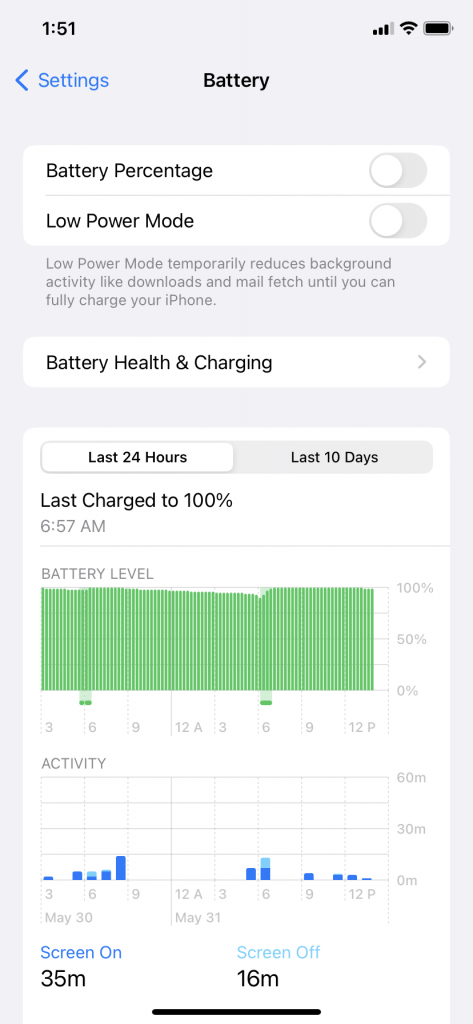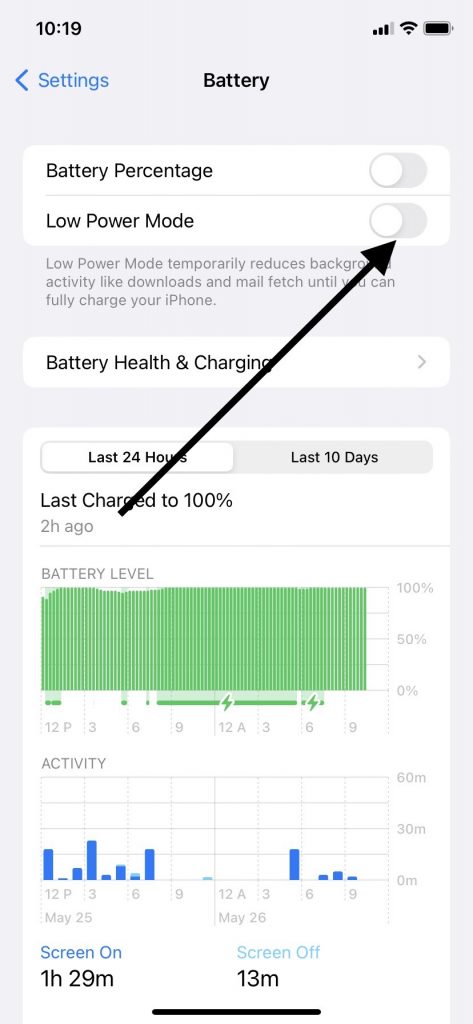If you own an iPhone, then you might want to know how to check iPhone battery health. The battery health is something that makes a huge difference in determining whether you can enjoy your device’s full functionality.
We will discuss your phone’s battery health right now. There are ways to get maximum capacity from your phone’s battery, and you should know how to make that happen.
What Does Battery Health Mean with iPhones?
The term “battery health” with iPhones means how long the phone’s battery will last in between its charging cycles. Battery life is usually thought of as another way to describe the same thing.
It’s relatively easy to see how much battery power your device has left. You can get an approximate idea just by glancing at the battery icon that appears in the upper right-hand corner of the screen on all iPhone models.
Your Phone’s Maximum Capacity Diminishes
However, you should also know that the battery health that an iPhone has when you first buy it does not stay that way. The iPhone’s battery health diminishes the longer you own it and the more you use it.
There’s no need to panic, since these phones are built to last. Just know that the battery capacity will diminish if you have your phone for several years, and that’s perfectly normal.
What is a Good Health Capacity for Your iPhone Battery?
It makes sense to wonder what kind of battery health your iPhone should have in order for you to still consider it to be in relatively good condition. Most consumers seem to feel that if your iPhone is capable of supporting a battery life of between 100% and 90%, then it’s still doing well.
What Kind of Performance Should You Realistically Expect?
If you’re getting normal peak performance from your phone, it should get to 100% every time you charge it. If it can’t get all the way up to 100%, even if you plug it into an outlet and charge it for quite some time, that’s a sure sign that it’s on the way out. You might be able to delay getting a new one by buying a replacement battery, though.
Your iPhone might also get to the point where it charges all the way up to 100%, but it doesn’t stay there for very long at all. This also happens with older models and ones that have seen a lot of continuous use.
You should charge your battery to at least 80% for it to operate at maximum capacity, and you should also try not to let it drop below 30% without charging it. This is a way that you can prolong the life of both the iPhone and the battery.
Now, talk about how you can check on the battery health of your iPhone.
How to Check an iPhone’s Battery Health in a Couple of Simple Steps
There’s an easy way to check on your iPhone’s battery health. All you have to do is go to Settings, and then tap Battery Health. It might also simply say Battery on some iPhone models.
If you see that your battery health is good, which most iPhone owners seem to think is about 80% or higher, than you’ll know you’re not in a situation where you need to charge the device urgently. You can also get quite a bit of additional information about your iPhone battery when you follow these directions.

What Else Can You Learn About Your iPhone Battery Health?
If you go to Settings and then tap Battery Health or Battery like we’ve suggested, you can find out there whether you have a battery that’s still supporting normal peak performance for your iPhone. You can see the recent battery capacity relative to the phone’s overall functionality on the screen that comes up.
You can see not just your current battery health, but also the battery’s usage and activity going back 24 hours. You may also see insights of various kinds depending on what iPhone model you have.
What Else Can You See Besides Your iPhone’s Battery Capacity?
The iPhone can do a lot of diagnostic work on itself, if you care to look at it. It can make suggestions and offer insights about what you’re doing that can affect your battery health and how to make it operate at maximum capacity.
You can peruse the suggestions about how to lower your energy consumption, but you have no obligation to do so. If you see that your battery health will improve if you use a particular app less, you can follow that advice or discard it.
You can also go back to that screen and check iPhone battery usage in real time if you suspect something you’re doing is adversely affecting your iPhone’s battery life.
What Can You Do to Get Peak Performance Capability?
If your iPhone’s battery life preoccupies you, you might follow the suggestions that the screen gives you when you go from the Settings app to the Battery screen. You can also put the phone in Low Power mode if you see that you’re losing your iPhone’s battery power fast, and you’d like to conserve it.
Go to Settings, and then Battery. There, you can turn Low Power mode off or on. That does a great job of conserving the iPhone’s battery if you want maximum battery capacity and it’s not convenient to charge the device at that moment.

What Should You Do if Your Battery Health Status Isn’t Doing So Well?
If you periodically check the battery health on your iPhone and see that it’s draining quickly or won’t charge all the way, then it’s a sure bet that your device is not currently supporting peak performance capability. Heading to an Apple-authorized service provider makes sense at that juncture.
You can show the phone to the Geniuses at the Apple Store and describe what’s happening. If it’s clear that your phone is not currently supporting normal peak battery power, they might suggest replacing the battery.
How Much Does an iPhone Battery Cost to Replace?
Apple might charge you as little as $49 or as much as $99 for a new battery, depending on how old of an iPhone model you have. That’s cheaper than buying a new iPhone in almost all instances, so you’ll probably feel that it’s worth it.
If you check iPhone battery health often and see that your battery is not performing like it should, then you’re probably not averse to getting a replacement. You want to be able to check battery health and see that you’re not getting a significant drain when you’re engaging in normal activities with the phone.
Your iPhone’s Warranty or an AppleCare+ Plan
If you bought your iPhone brand-new, then it should have come with a standard one-year warranty. That includes hardware problems, and replacing rechargeable batteries should qualify.
You might also have purchased an extended warranty or what the company calls an AppleCare+ plan. Those plans should also cover hardware-related issues like your battery’s capacity draining quickly.
If your device is no longer under warranty or an AppleCare+ plan, that’s when you might have to pay for the new battery out of pocket. We mentioned the price already, though, and most iPhone owners do not find it to be too prohibitive. Paying for lithium-ion batteries like your iPhone uses is not anywhere near as expensive of a fix as some other part replacements that a smartphone might require.
A new battery might deliver maximum instantaneous performance from your device, and ultimately, that’s what you want.






